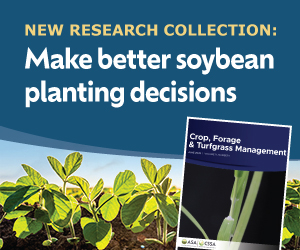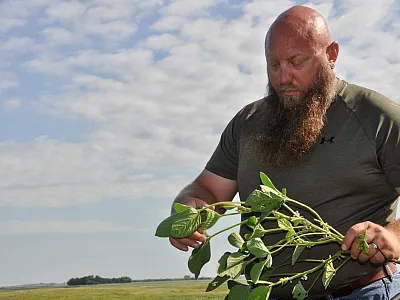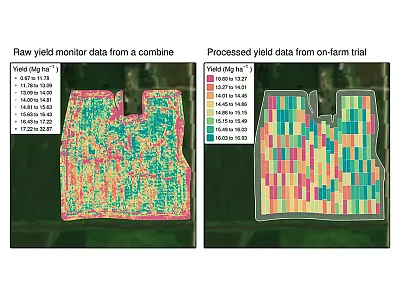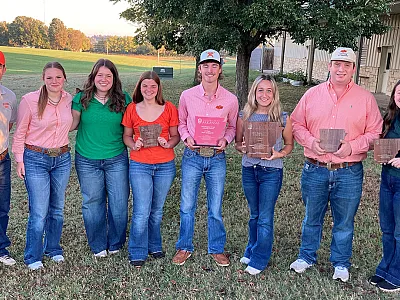Targeted weed management with precision sprayers in corn and soybean


Precision sprayers can detect and treat weeds simultaneously in real-time, enabling targeted weed management. This approach has the potential to reduce herbicide usage and associated costs. Although large-scale commercial precision sprayers are available for row crops, their weed control efficacy has not been extensively compared with traditional broadcast sprayers under field conditions.
New research evaluated the performance of precision sprayers (Greeneye Technology and John Deere) in corn and soybean production fields. Results indicated that both precision sprayers provided grass and broadleaf weed control comparable to broadcast sprayers with herbicide savings dependent on weed infestation.
Earn 0.5 CEUs in Integrated Pest Management by taking the quiz for the article.
Herbicides are commonly used for managing weeds in large-scale crop production, valued to their effectiveness, relatively lower cost, and ease of use. When applied properly, they help maximize crop yields by reducing weed competition. Often, herbicides are applied in row crops such as corn and soybean using broadcast sprayers where they are applied across the entire field, even in areas where weeds are not present, leading to unnecessary chemical use. In contrast, precision sprayers, equipped with cameras and sensors, detect weeds in real time and apply herbicides only where needed, reducing inputs, costs, and potential environmental risks. Depending on weed infestation, precision sprayers can reduce the amount of non-residual herbicides applied in the fields.
Although commercialized, precision sprayers have not been extensively tested in real-world field conditions. It is important to evaluate their weed control effectiveness compared with traditional broadcast sprayers in corn and soybean fields. If proven successful, precision sprayers could offer significant benefits to growers by reducing herbicide use and the associated environmental footprint and potentially even reducing crop injury.
The objective of this study was to assess the performance of spot spray (SS) technology versus traditional broadcast applications for early-postemergence (E-POST) and late-postemergence (L-POST) herbicide treatments in corn and soybean fields. Understanding precision spraying’s impact on weed control can help growers make informed decisions about adopting this technology for more efficient and sustainable weed management.
Methods

Field experiments were conducted in 2022 at the University of Nebraska–Lincoln's South-Central Agricultural Laboratory near Clay Center, NE, to test Greeneye Technology's precision sprayer in corn (Figure 1) and in 2023 at the Eastern Nebraska Research Extension and Education Center near Mead, NE to test John Deere's precision sprayer in soybean (Figure 2). Experiments consisted of comparing SS technology against broadcast application. The experiments were set up in a randomized complete block design with a plot size of 60 by 150 ft in 2022 and 60 by 250 ft in 2023.
In 2022, treatments comprised of application techniques consisting of broadcast only (using Tank 1 only), broadcast (Tank 1) + SS (Tank 2), and broadcast (Tank 1) + broadcast (Tank 2). The E-POST application consisted of Harness Xtra + Callisto in Tank 1 and DiFlexx + Roundup PowerMax in Tank 2. For L-POST, Harness Xtra + Aatrex + Callisto was applied from Tank 1, and Status + Roundup PowerMax was applied from Tank 2. Tank 1 was activated 100% of the time. The SS feature (Tank 2) was deactivated for the broadcast-only treatment for both E-POST and L-POST herbicide applications.
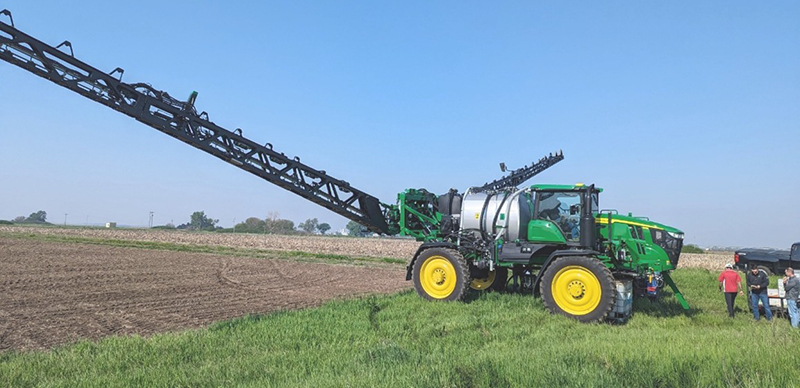
In 2023, four herbicide treatments were applied separately as broadcast and SS applications. These consisted of Enlist One (E-POST) followed by (fb) Liberty (L-POST), Roundup PowerMax fb Cobra, Liberty fb Roundup PowerMax, and Sharpen fb Enlist One. All herbicides were applied at labeled rates and mixed with required adjuvants. The weeds present included Palmer amaranth and giant foxtail in 2022 and kochia, waterhemp, and common lambsquarters in 2023. Visual control estimates of each weed species were assessed 21 days after herbicide application (DAA). Herbicide savings were calculated on a scale of 0–100% with 100% being the maximum amount of herbicide saved.
Results
Weed control
In 2022, broadcast + SS provided similar control for Palmer amaranth and giant foxtail compared with broadcast + broadcast at 21 DAA (Table 1). Similarly, in 2023, control ratings between broadcast and spot spray were similar regardless of weed species or herbicide used 21 days after E-POST and L-POST applications (Table 2). Weed control in 2022 or 2023 did not differ between a broadcast application compared with a SS herbicide application, indicating the importance of precision sprayers for precise weed management in corn and soybean.
| Application technique (Tank 1 + Tank 2) | 21 DAA | |
|---|---|---|
| Palmer amaranth | Giant foxtail | |
Control, % | ||
Broadcast | 93 b | 77 b |
Broadcast + spot spray | 99 a | 94 a |
Broadcast + broadcast | 99 a | 99 a |
P-value | .04 | .01 |
| Application technique | Common lambsquarters | Kochia | Waterhemp |
|---|---|---|---|
Control, % | |||
21 DAA (E-POST) | |||
Broadcast | 77 a | 67 a | 91 a |
Spot spray | 76 a | 69 a | 92 a |
21 DAA (L-POST) | |||
Broadcast | 75 a | 97 a | 88 a |
Spot spray | 78 a | 98 a | 90 a |
Herbicide savings
In 2022, weed pressure was minimal at the time of POST herbicide applications due to a residual pre-emergence herbicide applied at crop planting. With this, herbicide savings ranged from 87–94% (Table 3) while maintaining similar weed control. In 2023, no residual herbicides were applied, leading to higher weed pressure during the POST applications. Therefore, no more than 5% of herbicide savings were observed. It suggests that weed infestation at the time of POST herbicide application is one of the primary drivers of herbicide savings.
Tank 1 | Tank 2 | Timing | Herbicide savings, % |
|---|---|---|---|
Broadcast | N/A | E-POST fb L-POST | -- |
Broadcast | Spot Spray | E-POST fb L-POST | 94 fb 87 |
Broadcast | Broadcast | E-POST fb L-POST | 0 |
Note: fb, followed by. | |||
Summary
Precision sprayers were evaluated for targeted weed control effectiveness compared with traditional broadcast herbicide applications in Nebraska corn and soybean production fields. Results demonstrated that spot spray systems provided weed control comparable to broadcast applications. However, herbicide savings varied between years and were largely influenced by weed density. This finding indicates that targeted spraying could offer greater economic benefits in fields with lower weed pressure. In some precision sprayers, the sensitivity option may be adjusted per the operator's request to either increase weed detection or allow for more herbicide savings. However, proper herbicide coverage should be emphasized before herbicide savings to reduce weed seed production.
Dig deeper
Leise, A., Singh, M., La Menza, N.C., Knezevic, S., & Jhala, A.J. (2025). Evaluating precision sprayers for targeted weed management in corn and soybean. Agrosystems, Geosciences & Environment, 8, e70055. https://doi.org/10.1002/agg2.70055
Self-study CEU quiz
Earn 0.5 CEUs in Integrated Pest Management by taking the quiz for the article. For your convenience, the quiz is printed below. The CEU can be purchased individually, or you can access as part of your Online Classroom Subscription.
1. In the 2022 field trials in corn, what was the herbicide savings when using the broadcast + spot spray method during POST applications?
a. 0%.
b. 13–21%.
c. 34–39%.
d. 87–94%.
2. Which weed species was NOT mentioned as being present during the 2022 or 2023 trials?
a. Palmer amaranth.
b. Velvetleaf.
c. Common lambsquarters.
d. Giant foxtail.
3. According to the results, what factor primarily influenced herbicide savings in 2023?
a. Type of sprayer used.
b. Herbicide brand.
c. Operator experience.
d. Weed pressure at time of application.
4. In 2023 soybean trials using John Deere’s precision sprayer, spot spray was significantly more effective than broadcast.
a. True.
b. False.
5. Which herbicide combination was used in Tank 1 during the early-postemergence (E-POST) treatment in corn in 2022?
a. Harness Xtra + Callisto.
b. Status + Roundup PowerMax.
c. Enlist One + Liberty.
d. DiFlexx + Roundup PowerMax.
Text © . The authors. CC BY-NC-ND 4.0. Except where otherwise noted, images are subject to copyright. Any reuse without express permission from the copyright owner is prohibited.



